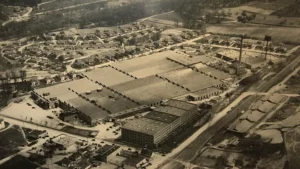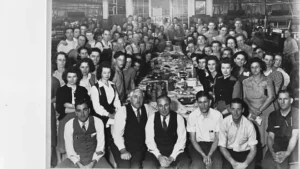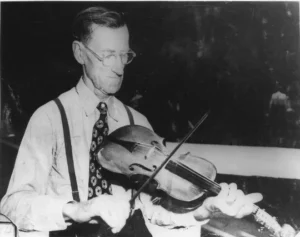“According to local legend, Beacon’s owner, Charles D. Owen, when Owen heard Martin’s masterful fiddling, he offered him a job on the spot and his family a place to live in the mill village.”



Beacon Manufacturing and a Swannanoa fiddling phenom
by Anne Chesky
In the midst of the Great Depression, when many Appalachians were losing their hard-won factory jobs and heading back to the farm, Marcus Lafayette Martin moved his family east to Swannanoa, about 12 miles outside of Asheville, where he, and later his sons, were able to find work in one of the nation’s largest blanket mills, Beacon Manufacturing. Back in Macon County, North Carolina, Martin had farmed and logged but had little experience in industry. So why was he able to find steady work when so many others were losing their jobs?
According to local legend, Beacon’s owner, Charles D. Owen, was fervently against unions, had even moved his entire company brick by brick south from Massachusetts to avoid them, and he figured the best way to stop his workers from trying unionize was to make sure they were happy. In a time before television, when few workers could afford to own a radio or go to the movies, live music and sporting events were the major forms of entertainment. So when Owen heard Martin’s masterful fiddling, he offered him a job on the spot and his family a place to live in the mill village.
Hiring based on musical talent or other skills unrelated to job performance was not uncommon in the early part of the 20th century. In fact, two of Martin’s sons found steady work at Beacon in part because of their talent on the baseball field. In many parts of the United States, industries hired musicians to form internal musical groups in hopes of promoting enthusiasm and encouraging loyalty among workers.
Even earlier, at the beginning of the 19th century, Virginians who were looking to buy enslaved people or acquire free servants often specified in advertisements that they wanted a musician because enslaved people and indentured servants composed most of the bands that played local dances.
By the mid-1800s, a fiddler could be found in almost every settlement in Southern Appalachia, including Cherokee communities. As the grandson of musically-inclined Cherokee Indian Chief John Martin (also known as Tsu-ni-tlu-tlu) and a Scots-Irish woman, Martin became inextricably tied to the origins and traditions of Western North Carolina music. The contributions he and his family made to the development of these traditions, however, might never have been known if not for an industry looking to appease its workers and keep them from unionizing.
Around the time Martin was born (1881) in the community of Aquone in Macon County, fiddles and other instruments began to be more accessible to the general public through mail-order catalogs. Despite this mass production, many fiddlers, like those in the Martin family, continued to hand-make their own instruments.
Martin’s father, Nathaniel “Rowan” Martin, taught him most of his repertoire and technique, and though Rowan himself never found acclaim as a musician, Martin remembered years after his father’s death that he “could play the sweetest you ever heard.”
Martin began playing publicly in his youth, often fiddling tunes unaccompanied at square dances around Macon and Cherokee counties. Years later, he married Callie Holloway, a “good five-string banjo picker” herself, and they had six children — five boys and a girl. In the 1920s, Martin separated from Callie and moved with his boys — Wade, Fred, Quentin, Wayne, and Edsel — from rural North Carolina to a quickly developing Swannanoa.
Though string bands had been part of the Swannanoa community for at least half a century before Marcus Martin came to town, it was the mill village that created a boom in the quality and quantity of music events in the town. Musicians, rather than being miles apart from each on their farms, were now living in close quarters with hundreds of non-musicians who looked to them for entertainment. It was in the mill town of Swannanoa that Martin became well known as a musician. And so, in Swannanoa and in many mill towns across the Appalachian South, the development of urban industrial centers encouraged the development and simultaneous preservation of traditional music that had most often been associated with rural areas.
A few years after the Martins made their move to Swannanoa, Bascom Lamar Lunsford began organizing the Mountain Dance and Folk Festival in Asheville. Martin became a favorite of Lunsford’s and opened the festival for many years with the traditional tune “Grey Eagle.” He continued to travel and play with Lunsford throughout his life, performing as far away as Renfro Valley, Kentucky, and Chapel Hill, North Carolina.
In the mid-1940s, recordings of many of Martin’s songs were made on old acetate discs and placed in the Library of Congress. Still Martin claimed he “didn’t know a thing about music.” In reality, he knew dozens of songs by heart and even won the title of “Champion Fiddler” at the 1949 North Carolina State Fair in Raleigh.
Though his music career was taking off, Martin still spent most of his time working as a watchman at the Beacon mill. In his spare time, he made fiddles to sell. He had learned to carve from his father, who “was gifted with wood,” according to Martin’s son Wade, but who had only used his skills for practical purposes, fashioning plow handles and other farming tools. Carving as an art form came later for the Martin men, when their factory jobs provided them with cash and free time.
Martin made fiddles and mountain dulcimers, always spending extra time to carve a scroll at the end of each instrument. And though he had stopped playing by the early 1960s, his sons had already learned much from their father. They all played music and carved, but Edsel was the most accomplished. Using only his pocket knife, he shaped likenesses of mountain people, whittled hound dogs, and carved native western North Carolina birds, some of which are now on display in the Smithsonian. The dulcimers Edsel made featured scrolls shaped into human faces, dog heads, and flowers. Musician and friend Billy Edd Wheeler remembered Edsel’s playing fondly: “He grew up with these songs, heard them played by his daddy as often as he heard the birds sing, and as naturally.”
Beacon Manufacturing began downsizing in the late 20th century because of increased automation and competition. The mill permanently closed in 2002 and an arsonist burnt the vacant building to the ground in 2003. But Marcus Martin’s legacy continued.
Today, old-time fiddlers still try to match his style by listening to his recordings. Many of his old-time tunes have been adapted by modern fiddlers, including some of his most unusual songs such as “Lady Hamilton” and “Jenny Run Away in the Mud in the Night.”
Owen, Beacon’s owner, may have originally viewed Marcus Martin as a tool that could save him time and money by helping keep the mill’s workers content, but by hiring Martin and other musicians, Owen also brought the music of rural Western North Carolina to a broader audience, many of whom had moved south from Massachusetts with Beacon in the 1920s. Factory jobs not only brought together people who would hear and remember the tunes but also allowed the tradition bearers free time to develop and promote their art. By doing so, these urban areas helped preserve rural traditions of transplanted workers even as these workers abandoned their rural lifestyle.
In 2023, the land that once held the booming industry that brought the Martin family to Swannanoa has yet to be redeveloped, but Martin and his magic hands are still remembered. It is said that he could “fiddle a possum out of a tree, fiddle all the bugs off a sweet potato vine, and fiddle the heart right out of your throat.”
Anne Chesky Smith is the Executive Director of the Asheville Museum of History.
